Do you own a 1974 quarter and are curious about the potential sale price?
You might have thought of adding this coin to your collection. This is can
be because of the 1974 quarter value and its rarity. It is true - that
they were produced in large quantities, but a few had unique errors or
flaws that made them moresought after for collectors and investors.
The Washington Quarter series, which debuted in 1932, includes the 1974
quarter. You may be considering purchasing one of these to add to your
collection of antique coins.
It is helpful to know the coin's precise market value whether you plan to
buy or sell. That's precisely what this post will assist you with!
In the end, you'll know roughly how much your 1974 Washington quarter is
worth when you buy or sell it.
1974 Quarter Value and Types
Do you own a 1974 quarter and are curious about the potential sale price?
You might have thought of adding this coin to your collection. This is can
be because of the 1974 quarter value and its rarity. It is true - that
they were produced in large quantities, but a few had unique errors or
flaws that made them moresought after for collectors and investors.
The Washington Quarter series, which debuted in 1932, includes the 1974
quarter. You may be considering purchasing one of these to add to your
collection of antique coins.
It is helpful to know the coin's precise market value whether you plan to
buy or sell. That's precisely what this post will assist you with!
In the end, you'll know roughly how much your 1974 Washington quarter is
worth when you buy or sell it.
1974 Quarter Value and Types
In 1974, the
United States Mintt produced over 1.57 billion Washington quarters. Since there are so many
of them, they are fairly common and reasonably priced for any collector.
Depending on where the coins were struck, the 1974 quarter comes in three
different forms. Among them are:
- 1974 No Mint Mark Quarter
- 1974 D Quarter
- 1974 S Quarter (Proof)
Now, we will examine the worth of each type so you can understand the
selling or purchasing price of a Washington quarter.
1974 No Mint Mark Quarter Value
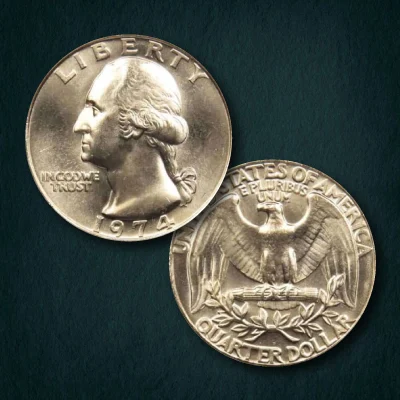
In 1974, the Philadelphia Mint produced the greatest number of
Washington quarters
ever, about 801,456,000.
The absence of a mint mark is the most telling feature of Philadelphia
quarters. These no-mint mark coins are very common because of their
enormous mintage, which makes them reasonably priced to acquire
specimens of.
1974 P quarters are readily available even in uncirculated form, and
this is particularly true of coins in lower mint state grades. Higher
up the scale are quarters of gem qualities that are far more valuable.
The 1974 quarter value in circulating condition is $6.81. Lower down
the scale, mint state coins see a very minor price increase. An MS60,
for instance, costs roughly $1.0, whereas an MS65 is sold for over
$26.
Up on the scale, you'll see that coins in mint state are worth a lot
more than regular coins. Prices may go up to $260 for an MS67 grade.
A rare quarter in mint state (MS67+) fetched $2,115 at auction in
2020, according to data from the Professional Coin Grading Service
(PCGS).
The following table shows the coin's grade, condition, and value with
various quality levels:
| Circulated |
Standard wear |
$6.81 |
| MS60 |
Lower uncirculated grade |
$1.00 |
| MS65 |
Higher uncirculated grade |
$26 |
| MS67 |
Gem quality |
$260 |
| MS67+ |
Auction record (2020) |
$2,115 |
1974 D Quarter Value
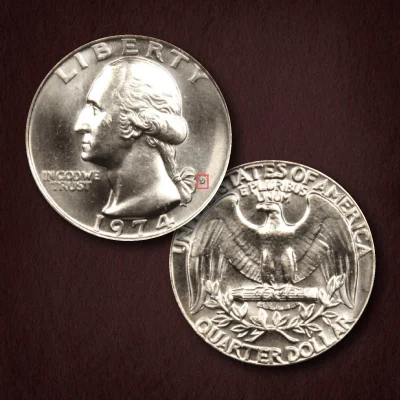
Almost one quarter of the mintage produced at the Philadelphia plant
was manufactured at the Denver mint. With an estimated mintage of
353,160,300 quarters in 1974, these coins are highly prevalent.
The bulk of the coins struck in Denver will be in circulated condition
or lower grades of uncirculated mint state because the majority were
released into circulation.
The 1974 quarter value for circulated coins ranges from $0.30 to
$8.07. Additionally, mint state quarters are reasonably priced; an
MS60 costs just $1, while an MS66 costs $38.
A 1974 Washington quarter in gem condition may bring $275 or more,
depending on the condition. At an online auction, a specimen with the
grade MS67 brought approximately $1,450.
| Circulated |
Standard wear |
$0.30 - $8.07 |
| MS60 |
Lower uncirculated grade |
$1.00 |
| MS66 |
Higher uncirculated grade |
$38 |
| MS67 |
Gem quality |
$275 |
| MS67+ |
Auction record |
$1,450 |
1974 S Quarter Proof Value
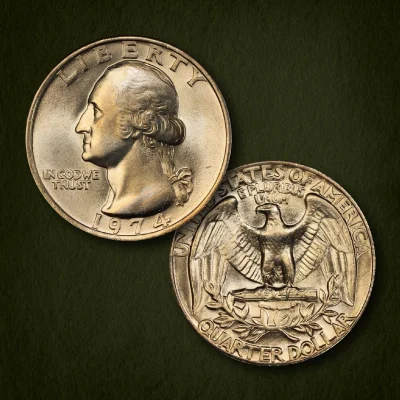
In 1974, no regular circulation strikes in Washington quarters were
produced at the San Francisco Mint. Instead, it produced roughly
2,612,568 proof coins for enthusiasts.
Proof coins typically have a satin-like sheen, frosted features,
strong contrast, and excellent visual appeal. They are also typically
of a superior strike grade.
The Mint typically produces a small number of proofs for collectors,
although occasionally, like with the 1974 S proof quarters, the proof
mintage can reach the millions.
Even for a novice collector on a tight budget, these proofs are
readily available, with over 2 million copies struck. Market
availability is typical for proofs up to PF66, but beyond PF69, these
become unattainable.
There are three versions of the 1974 S quarters: standard proof,
cameo, and deep cameo. The value of a standard MS69 is approximately
$15, which is fairly reasonable for any collector.
In 1974, there were no regular strikes in Washington quarters produced
at the San Francisco mint. Instead, it produced roughly 2,612,568
proof coins for enthusiasts.
Proof coins typically have a satin-like sheen, frosted features, strong
contrast, and excellent visual appeal. They are also normally of a
superior strike grade.
The Mint typically produces a small number of proofs for collectors,
although occasionally, like with the 1974 S proof quarters, the proof
mintage can reach the millions.
Even for a novice collector on a tight budget, these proofs are readily
available, with over 2 million copies struck. Market availability is
typical for proofs up to PF66, but beyond PF69, these become unattainable.
There are three versions of the 1974 S quarters: standard proof, cameo,
and deep cameo. The value of a standard MS69 is approximately $15, which
is fairly reasonable for any collector.
The following table presents the coin's grade, condition, and value among
a few quality levels:
Rare 1974 Quarter Error List
As we've seen, 1974 Washington quarters are usually valued at face value,
and some can even be purchased for $2 or less if they're in immaculate
condition.
Nevertheless, a coin's value can rise significantly due to certain minting
faults. There will inevitably be a significant number of mistake coins
with the 1974 quarters series' massive mintage, some of which are quite
valuable.
Let's examine several typical 1974 quarter errors to be aware of:
1974 Clipped Planchet Quarter Error
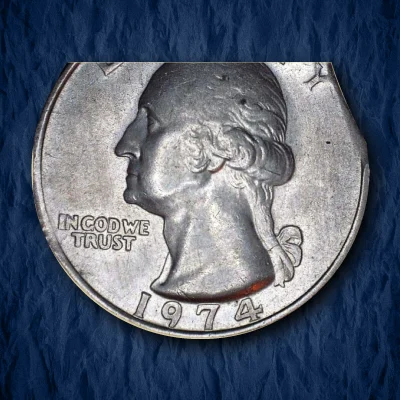
A planchet mistake that is clipped occurs when the planchet is being
cut and shaped. A chipped or partial planchet is the consequence of
the machinery cutting the planchet from a bigger metal sheet, failing
to produce a complete circular planchet.
The chipped planchet is struck as normal when it travels along the
striking hub, but because part of the planchet is missing, the design
doesn't fit together perfectly.
Examples of clipped planchet 1974 quarter faults are scarce. The value
of this minting fault can reach $200, depending on how much of the
breakage there is.
| Clipped Planchet Error |
Incomplete circular planchet |
Up to $200 |
1974 Off-Center Stroke Quarter Error
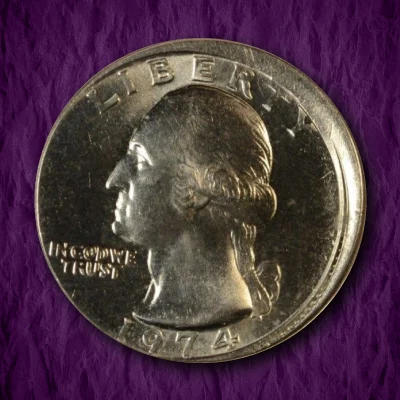
Off-center hits are somewhat typical in Washington quarters from 1974.
When the planchet is not positioned correctly in the striking hub, an
error occurs. As a result, the die strikes the design nearer the
coin's edge rather than in its middle. A coin with an off-center
strike fault will have one half blank and the other half partially
filled in with design features.
The 1974 quarter value with an off-center error can be found using the
off-strike percentage. The coin's value increases as the off-strike
percentage rises.
Depending on the condition, quarters with more than 50% off-strike
might fetch up to $150.
| Off-Center Strike Error |
>50% off-strike |
Up to $150 |
Conclusion
The bottom line is that the 1974 quarter value may appear common at
first glance, but its high mintage and mint markings drive its worth for
collectors and investors. It is also notable that these quarters, with
1.57 billion coined, are quite plentiful and hold little value unless
they happen to be rare or flawed.
Knowing the various types, such as no mint mark, Denver, and San
Francisco proof coins, will be helpful for you whether you are selling
or buying in estimating the true value of your coin. Besides this,
extremely rare minting errors, such as off-center strikes or clipped
planchets, increase the value of the coin immensely.
Well, if you have a 1974 quarter, now may be the time to give it a
second look because it may be well worth more than you think in your
collection!
FAQ
1. What makes a 1974 quarter valuable?
Despite their apparent value of $0.25, 1974 quarters are practically junk.
However, a mistake can make these relatively contemporary coins far more
valuable. Keep an eye out for uncommon but intriguing faults like doubled
dice, clipped, and off-center strikes, as these can increase the amount
you receive for your 1974 quarters.
2. What is the value of a 1974 quarter?
As of September 2024, the NGC Price Guide states that the value of a 1974
Washington quarter in circulated condition ranges from $0.30 to $0.85. On
the open market, however, flawless, uncirculated 1974 D Quarters can get
up to $275.
